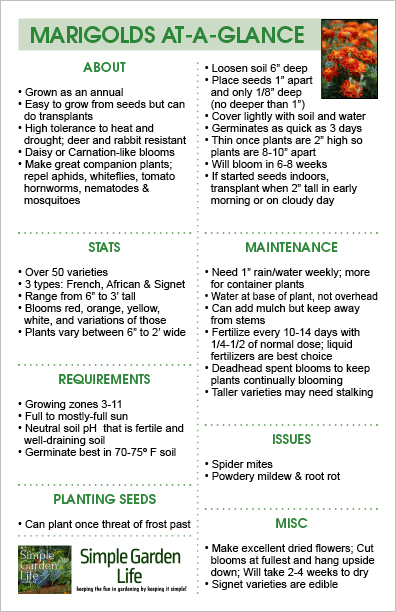Marigolds are known for their fiery hues of oranges, reds, and yellows, but that isn’t the only aspect that makes them a great annual to know how to grow!
They have a high tolerance to heat and drought, are typically deer and rabbit resistant, and make great companion plants. In addition, they are incredibly easy to plant and grow.
Marigolds grow almost anywhere but are best in Zones 3 to 11. You can find your own Growing Zone Here.
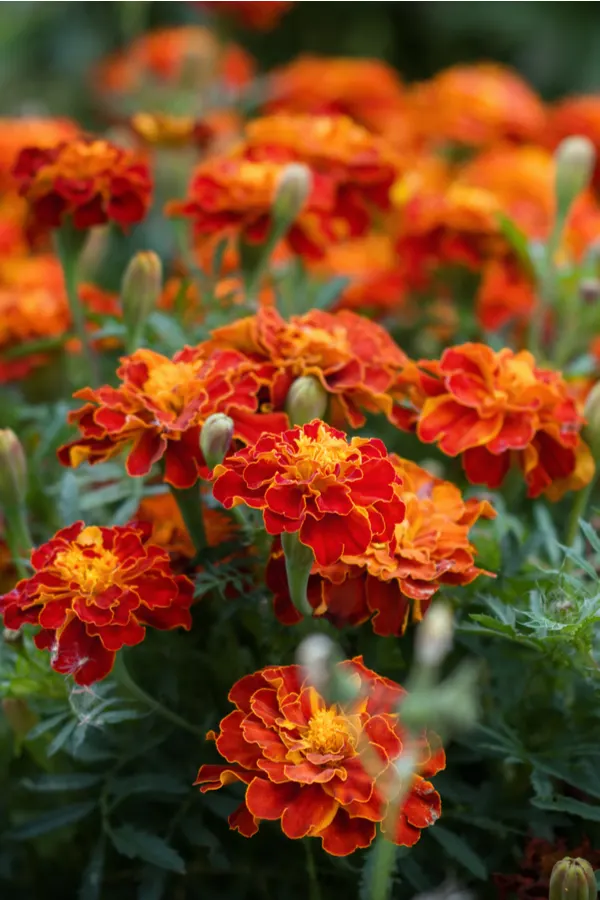
With their daisy / carnation like blooms, they are a great addition to any garden, especially vegetable gardens.
Honey bees, butterflies, moths, and other pollinators are all attracted to marigolds and their warm colors and abundant blooms. So when marigolds are planted in your vegetable garden, those beneficial insects will be around in plenty to help pollinate your vegetables as well.
Added Benefits of Marigolds
Not only are marigolds easy to grow and maintain, but they have a few added benefits that can help out your entire garden as well as yourself.
Marigolds are a great companion plant when grown near tomatoes, peppers, and cucumbers. They are known to actually repel aphids, whiteflies, tomato hornworms, nematodes, and more. Their scent is also highly offensive to mosquitoes as well.
And did you know that one variety of marigolds is actually edible? Talk about your do-it-all plant!
By following these tips and suggestions, you will be able to enjoy growing this versatile and beautiful flower in your own garden and landscape in no time at all.
Varieties of Marigolds – How To Grow Marigolds
There are over 50 different varieties of marigolds, so there is definitely a variety for any location. Marigolds typically come in colors of red, orange, yellow, white, and variations of those warming hues.
They range in size from 6 inches to up to over 3 feet tall for some varieties. Their blooms vary from around 2 inches across to over 5 inches wide.
There are three main types of marigolds: French, African, and Signet. The French Marigolds typically are shorter, bushier plants that grow around 6 to 18 inches tall. They have blooms that are 2 inches across.
African Marigolds (also known as Aztec or American Marigolds) are taller plants that have larger, pom pom-like flowers. Signet flowers are edible varieties that have small, daisy-like flowers.
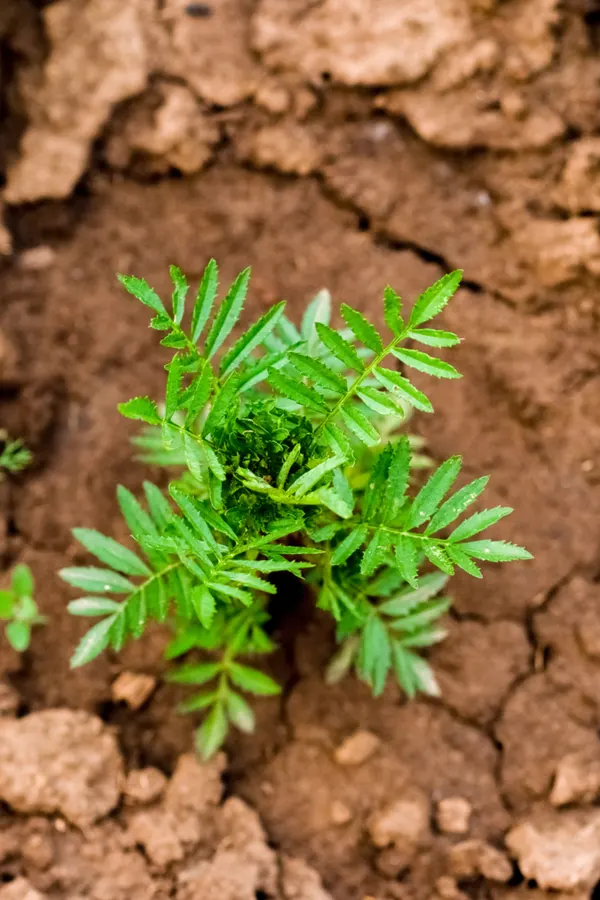
How To Plant, Grow, And Maintain Marigolds
Soil Requirements for Marigolds
Thankfully, marigolds aren’t really picky about where they are grown as long as the soil is moderately fertile and well draining. They can be grown in about any soil type that has a neutral pH.
The soil temperature isn’t as important for marigolds, but they will germinate quickest once the soil temperature has reached 70 to 75 degrees Fahrenheit (21 to 24 degrees Celsius).
Planting Marigolds
You can start marigolds indoors and grow them as transplants, but they grow so easily and quickly from seeds that it really isn’t needed!
Once the threat of frost is past, you can plant your marigolds seeds. (Find your Last Spring Frost Date Here.) The taller African marigolds should be planted sooner since they take a bit longer to reach maturity. However, all varieties will germinate quicker if the soil has warmed some.
Plant in a location of full to mostly-full sun for best results. Marigolds that are planted in cool, moist, and shady areas are more prone to getting powdery mildew, so full sun is always the best choice.
Taller African varieties may need staking, so keep that in mind when picking out your planting location.
Loosen the soil around 6 inches deep where you wish to plant the marigold seeds. Place seeds about 1 inch apart and only about ⅛ inch deep (no deeper than 1 inch). Cover lightly with soil and water thoroughly.

Long-Term Care – How To Grow and Maintain Marigolds
Germination can be as quick as 3 days when soil temperatures are warm enough. Once plants are around 2 inches high, thin most varieties to 8 to 10 inches apart (10-12 inches for taller varieties).
Mature marigolds can be anywhere from 6 inches wide for French varieties to over 2 feet wide for some of the African varieties, so check your seed packet for specific growing distances between seeds.
Within 6 to 8 weeks, the marigolds will be blooming and beautiful.
If you start your seeds indoors, transplant them when they are about 2 inches tall. Whenever you plant your transplants, make sure to do so in the early morning or on a cloudy day so the sun doesn’t cause too big of a shock to the new plants.
Watering
Proper watering is extremely important to the health of marigolds. To achieve maximum blooms, marigolds should receive around 1 inch of rain each week, either by rainfall or by watering.
For marigolds that are in pots and containers, you might have to water them daily. Stick the tip of your finger down about an inch below the surface to feel the soil moisture. If it feels dry, water. If it feels moist, hold off until the next day.
A couple of tips to note: Be careful not to overwater because marigold roots can be susceptible to root rot if left to sit in water. Make sure to water at the base of the plant. You can add mulch to help aid in the retention of moisture, just be sure to leave a few inches away from the stem mulch free.
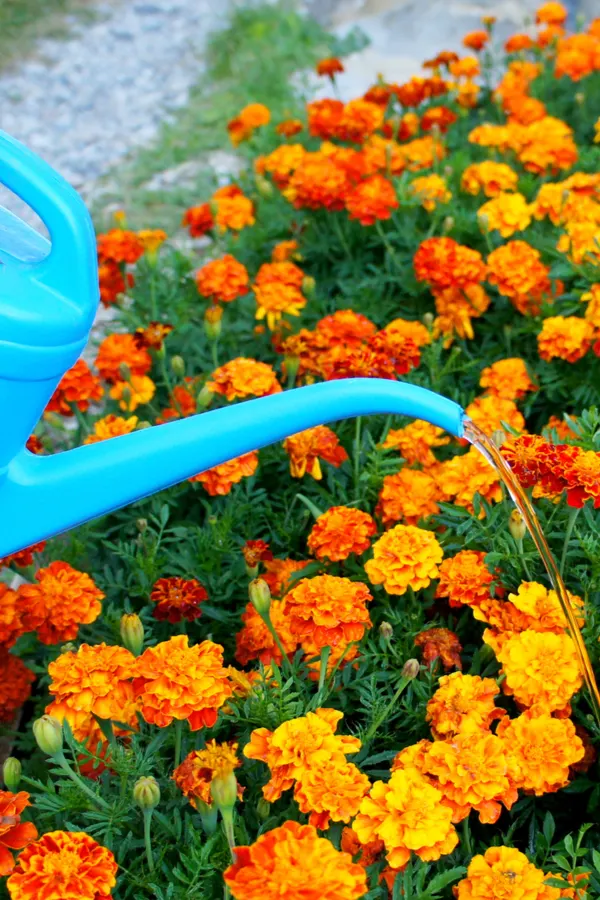
Fertilizing
Marigolds definitely benefit from the addition of fertilizers. It takes a lot of nutrients and energy for the plant to continually produce blooms, so giving the plant an extra boost can really help. As with most plants, a slow, consistent dose of fertilizer is better than large doses all at once.
For optimum results, fertilize marigolds every 10 to 14 days with ¼ to ½ of the normal recommended dose of your favorite flower fertilizer.
Liquid fertilizers are the best choice for marigolds since the nutrients can quickly be absorbed and used. Compost tea and worm castings are also both great all-natural fertilizer choices for marigolds.
Deadheading
One of the most important things you need to do to help keep marigolds continually blooming is deadheading!
Plants will continue to send nutrients and resources to blooms, even if they are starting to die off. If you fail to remove those dead blooms, you will keep the plants from making and producing new blooms.
It’s really simple and easy to remove fading blooms. By using either a sharp pair of scissors or even your nails, just pinch off the bloom down to the nearest set of leaves. The more you pinch back and deadhead, the more blooms the plant will make.
To find out more about deadheading marigolds, check out the podcast, How To Deadhead Annuals & Perennials.
Pests & Issues
There is really only one pest that is a big issue for marigolds, and that is spider mites. One way to naturally help win the battle against spider mites is by adding ladybugs to your plants.
Other challenges for marigolds are powdery mildew and root rot. Helping to keep plants spaced properly apart, watering at the base of the plant, and not letting them stay in standing water will help discourage those diseases.
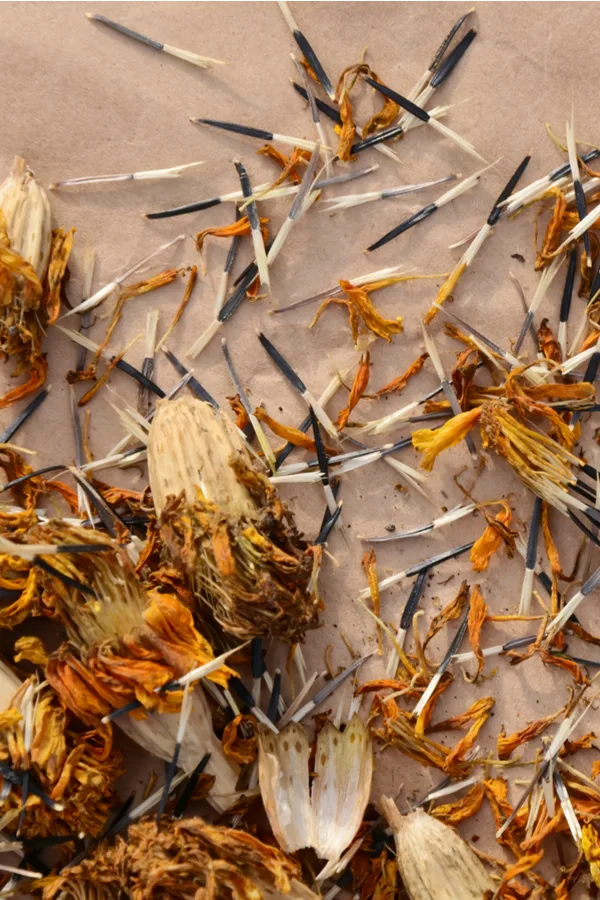
Cut & Dried Flowers
Marigolds can make fun cut flowers that will last up to a week in water. Cut stems at an angle and remove any leaves that are standing in the water.
Marigolds also make excellent dried flowers for wreaths or displays. When blooms are at their fullest, cut the stems and hang upside down. It will take two to four weeks for them to dry completely. You can tell they are ready when the stem has shrunk some and the petals are completely dry to touch.
Saving Seeds
It’s really easy to save the seeds from marigold plants. Simply let the heads dry on the plant. Once they are dry and brittle, cut the blooms off, remove the dried petals, and either shake out the seeds or gently pull them loose. Store the seeds in a brown paper bag in a cool, dry location over winter. They will be ready to plant come Spring.
To Conclude…
If you are looking for a beneficial flower that also adds beauty and color to your garden area, consider growing marigolds. They are the insect repelling, constant blooming, do-it-all flower that’s easy to grow and simple to maintain!
Feel free to download, print out, or save our Marigolds At-A-Glance sheet. It is sized for half letter printing but can be scaled if needed.
